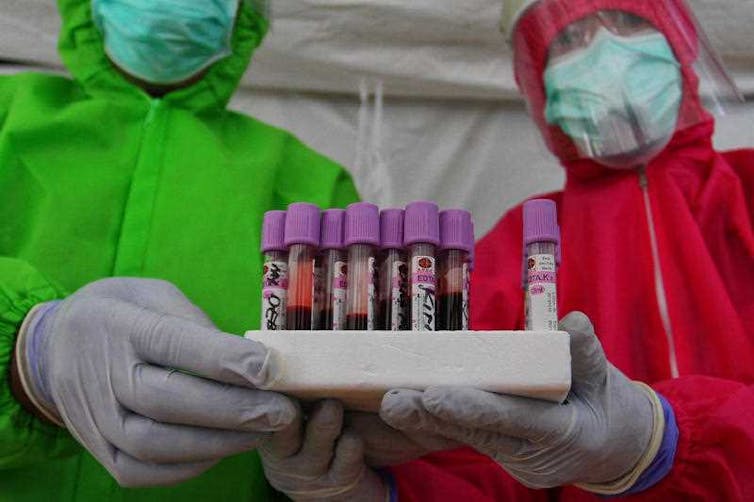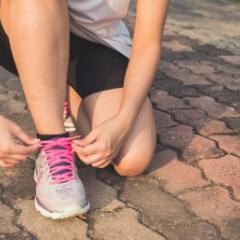Dr Jenny Munro and Dr Sarah Richards-Hewat, The University of Queensland
View more articles from Dr Munro and Dr Richards-Hewat on The Conversation
It is likely COVID-19 is hitting Indonesia hard even though accurate testing has not been available to prove it. Indonesian researchers say the death toll is likely to be much higher than the official figures.
What we know from decades of fighting HIV in Indonesia is that there are no simple or quick fixes in an epidemic. Prevention goes beyond the bio-medical abilities to test and treat. Remember, universal access to HIV testing and treatment still has not been achieved despite decades of work.
Testing needs to be equally available to all, and people have to agree to it. If they do not feel sick or think they need testing, or they cannot access it, it is not a very effective mode of prevention. We don’t think mass testing should be forced, or that testing can be scaled up quickly enough.
Reflecting on our experiences as anthropologists working on HIV and gender in eastern Indonesia for nearly two decades, we suggest a holistic approach, that takes into account culture, gender, religion, economy and politics to address the social aspects of transmission and prevention. To be effective, prevention strategies must engage with the everyday lives of people and be integrated into their social relations and practices.
Pay attention to the local context
Public health strategies that have proved effective in other countries are not necessarily welcome or easily replicated in many parts of Indonesia.
Hand washing with soap and clean water is not so easily accomplished for many Indonesians. Only 11% of Indonesian households have piped water inside their dwelling, and even then the quality is often low. In Papua province in the eastern part of Indonesia, only around 35% of the population has access to public hand-washing facilities with piped water and soap. This is due to limited infrastructure, lack of waterway protection, and water privatisation.
The Indonesian government has recommended people stay at home to avoid spreading the highly contagious virus. But this policy is not suitable for almost 60% of the workforce, or around 74 million people, who work in informal sectors. Street vendors, spa workers, domestic workers and shopkeepers, for example, cannot work remotely or earn money if they stay at home. Social distancing measures are an unaffordable luxury for the majority whose incomes are precarious.
Addressing the economics of transmission creates a need for expanded government financial assistance and other forms of support so workers who depend on daily earnings in the informal economy, the majority of whom are women, can stay home. Government support in the form of essential goods – including auto top-ups of things like electricity and mobile phone credit – will help to keep people at home.
The local context is key. Different solutions will be needed for different situations.
Effective prevention means engaging with religion and culture
Indonesians are drawing from faith and tradition to find local solutions to prevent COVID-19.
For example, in Kepuh village in Central Java’s Sukoharjo regency, young men guard the entrance of Kesongo hamlet dressed up as pocong (shrouded ghosts from legend) to raise awareness that COVID-19 can kill.
Instead of framing talismans and rituals as exotic curiosities, find opportunities in these respected aspects of Indonesian life.
Religious and cultural leaders can translate health advice into more persuasive and relevant terms.
In the world’s largest Muslim country, religious groups also play their roles.
The secretary-general of the country’s second-largest Muslim organisation, Indonesian Ulema Council, Anwar Abbas, has supported the government’s position on mudik, a ritual for people to return to their home towns during the Muslim holiday of Idul Fitri. He told his followers mudik is sinful as it endangers oneself and others.
Many Indonesians already wear face coverings, such as women’s hijab worn for religious reasons or men’s bandana to deal with poor urban air quality. Despite some divergent medical advice on the utility of masks for preventing transmission, these coverings can be used to help contain the spread of airborne virus, if they are used properly.
Efforts should focus on raising awareness about how face coverings can best be used to prevent transmission.
Build on what works
New makeshift hospitals take too long to build and can create transmission opportunities, not only during construction but when sick people and doctors interact in an environment that is impossible to keep clean. Construction workers are better off delivering supplies and keeping the food chain moving.

Similarly, vaccines take years to produce, let alone distribute, and vaccination is no simple feat, as we know from the low rates of childhood vaccination in many parts of Indonesia.
Since Indonesia already has a strong tradition of mobile services, why not focus on developing tele-health or video conferencing?
It is important to reserve hospitals for those who are seriously ill and cannot be assisted at home or over the phone. This is partly because health workers tend to get infected and spread the virus to ill and vulnerable people. Relatives who often accompany a patient are put at risk and may then infect others.
App-based mobile delivery of food and essential items is an asset that can be leveraged for urban Indonesia, and would repurpose unemployed Gojek workers.
See opportunities for change
Testing, social distancing and other strategies are an important part of the solution to the spread of coronavirus in Indonesia. Low-tech and culturally meaningful prevention measures that build on existing capabilities are also essential.
But epidemics show us in vivid detail the cracks in our societies: the violence, discrimination, vulnerabilities and inequalities. Disease is the embodiment of inequality.
Thus, it is equally important to reflect on the values and practices that have led us not just to the new coronavirus or slow responses, but to the health inequalities that put so many Indonesians, and others, at risk in the first place.![]()
Jenny Munro, Lecturer, School of Social Science, The University of Queensland and Sarah Richards-Hewat, Research Associate, School of Social Science, The University of Queensland
This article is republished from The Conversation under a Creative Commons license. Read the original article.



